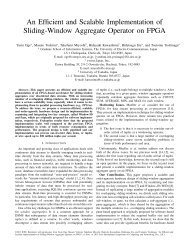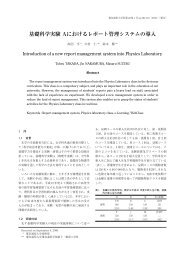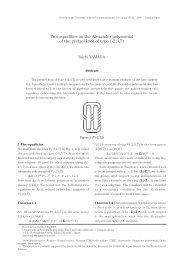Approximation of Hessian Matrix for Second-order SPSA Algorithm ...
Approximation of Hessian Matrix for Second-order SPSA Algorithm ...
Approximation of Hessian Matrix for Second-order SPSA Algorithm ...
You also want an ePaper? Increase the reach of your titles
YUMPU automatically turns print PDFs into web optimized ePapers that Google loves.
2.6 FISHER INFORMATION MATRIX<br />
required first or second derivatives <strong>of</strong> the log-likelihood function may be a <strong>for</strong>midable<br />
task in some applications, and computing the required expectation <strong>of</strong> the generally non-linear<br />
multivariate function is <strong>of</strong>ten impossible in problems <strong>of</strong> practical interest. This section outlines<br />
a computer resampling approach to estimating F n(θ ) that is useful when analytical methods<br />
<strong>for</strong> computing F n(θ ) are infeasible. The approach makes use <strong>of</strong> a computationally efficient<br />
and easy-to-implement method <strong>for</strong> <strong>Hessian</strong> estimation that was described by Spall[24] in the<br />
context <strong>of</strong> optimization.<br />
The computational efficiency follows by the low number <strong>of</strong> log-likelihood or gradient values<br />
needed to produce each <strong>Hessian</strong> estimate. Although there is no optimization here per se, we use<br />
the same basic simultaneous perturbation (SP) <strong>for</strong>mula <strong>for</strong> <strong>Hessian</strong> estimation [this is the same<br />
SP principle given earlier in Spall[24] <strong>for</strong> gradient estimation]. However, the way in which the<br />
individual <strong>Hessian</strong> estimates are averaged differs from Spall[24] because <strong>of</strong> the distinction<br />
between the problem <strong>of</strong> recursive optimization and the problem <strong>of</strong> estimation <strong>of</strong> F n(θ ) . The<br />
essence <strong>of</strong> the method is to produce a large number <strong>of</strong> SP estimates <strong>of</strong> the <strong>Hessian</strong> matrix <strong>of</strong><br />
logl ( ⋅)<br />
and then average the negative <strong>of</strong> these estimates to obtain an approximation to<br />
F n(θ ) .<br />
This approach is directly motivated by the definition <strong>of</strong> F n(θ ) as the main value <strong>of</strong> the<br />
negative <strong>Hessian</strong> matrix (2.29). To produce the SP <strong>Hessian</strong> estimates, we generate pseudodata<br />
vectors in a Monte Carlo manner. The pseudodata are generated according to a bootstrap<br />
resampling scheme treating the chosen θ as “truth.” The pseudodata are generated according<br />
to the probability model p f<br />
z( ζ θ ) given in (2.27). So, <strong>for</strong> example, if it is assumed that the<br />
real data Zn are jointly normally distributed, N ( µ ( θ ), Σ(<br />
θ )) , then the pseudodata are<br />
generated by Monte Carlo according to a normal distribution based on a mean µ and<br />
covariance matrix Σ evaluated at the chosen θ . Let the i-th pseudodata vector be Z pseudo<br />
(i)<br />
;<br />
the use <strong>of</strong><br />
Z<br />
pseudo<br />
without the argument is a generic reference to a pseudodata vector. This data<br />
vector represents a sample <strong>of</strong> size n from the assumed distribution <strong>for</strong> the set <strong>of</strong> data based on<br />
35

















